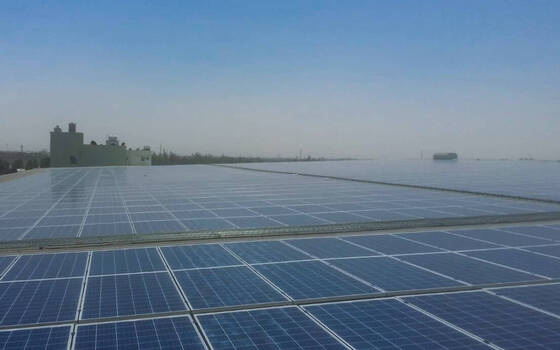Click here for more information on silicon carbide inverters
Interview: How to convert a warehouse roof into a cost-saving 1 MW solar power plant
Bringing 1500 V technology and silicon carbide inverters to Saudi Arabia
November 7, 2019
Dammam is located at the East coast of Saudi Arabia and the largest industrial city in the Kingdom. It’s only fitting that it is now home to a "lighthouse" PV project. It demonstrates the benefits of state-of-the-art solar technology for businesses: The solar roof is the first in Saudi Arabia to use 1500 V components and novel silicon carbide inverters by KACO new energy.
The plant is owned by Universal Cold Stores and situated on the company’s main distribution warehouse. The system was realised and managed by the EPC company Samera Alkhaleej for General Contracting Ltd and components were sourced with the assistance of Global Solar Projects (GSP). Rizwan Riaz of Samera Alkhaleej worked with GSP on the selection of components for the build, and chose KACO new energy as its preferred supplier for the inverters.
Andrew Edwards of GSP, lead engineer of the project for Samera Alkhaleej, and Andy Walsh, Regional Sales Manager at KACO new energy, shed some light on the Why and How of the installation and how to overcome the challenges of a hot and dusty environment with latest technology.
What was the reasoning behind Universal Cold Stores decision to order a solar PV system for one of their largest roofs?
Andy Walsh: The impetus comes from Saudi Arabia’s Vision 2030. Part of the program is to make the economy much more sustainable and to reduce the dependence on oil. Increasing oil prices for power supply is one of the results, for example.
Andrew Edwards: Universal Cold Stores is an early mover in embracing the opportunities that solar energy offers under these circumstances. They consume the solar power directly on site to save on energy costs. Since the energy comes from a one megawatt solar roof, this is the largest private wire installation in Saudi Arabia.
It’s also the first installation there that makes use of 1500 Volt technology.
Andrew Edwards: Yes. The project is privately funded and seen as an investment in the future. Hence, it was easy to convince Universal Cold Stores of the 1500 Volt advantages. A higher voltage means that you can build longer strings – resulting in less module rows. As a consequence, you can spare yourself components. And: The expenses for the electricians doing the wiring and connections will go down, too. This way, we expect a return-on-investment in only five to six years.
What else does such a speedy return-on-investment depend upon?
Andy Walsh: Saudi Arabia is not only rich on oil, but obviously also on sunlight. So, the geographical situation plays into our hands. On the other hand, some electrical devices are susceptible to heat, others to high solar irradiation. This is true to a certain extent for PV equipment, as well.
Andrew Edwards: That’s why we chose PV modules that are equipped against light induced degradation and KACO new energy inverters. The inverters are the only ones I know of that enter a performance derating only at ambient temperatures well above 50 °C. This gives the whole of the installation a better and lasting performance.
Andy Walsh: The favourable thermal behaviour of our blueplanet 125 TL3 inverter is due to using silicon carbide (SiC) as semiconductor material for the power switches. In contrast to conventional silicon, SiC dissipates less heat. This has positive effects on size, as well. We were able to shrink the heat sink, among other things, and have achieved an excellent power-to-weight ratio.
The landscape in Saudi Arabia is dominated by deserts. Do you have to take sand and dust into account?
Andrew Edwards: Yes, Rizwan Riaz and the Team of Samera Alkhaleej was and is very conscious of this, and the issue had to be considered at the point of design. There was no discussion that a monitoring system was needed to track plant performance. However, KACO new energy and Meteocontrol worked together to figure out the details. Although we had anticipated it, the monitoring data showed that soiling of the PV modules by dust was indeed extreme. Even though, our yield prognoses have been excelled and the plant has initially been performing at seven percent above expectations! Since we have gained a fair idea of how to alleviate the soiling aspect, our customer’s business case looks even brighter in reality than on paper.
Andy Walsh: I think it’s safe to say that if more businesses in industrial areas switched to clean energy for power supply, this would lessen soiling by pollution – although the sand dust is still a challenge. It would also reflect positively on people’s well-being. Let’s not forget that air pollution is a serious hazard to health.





